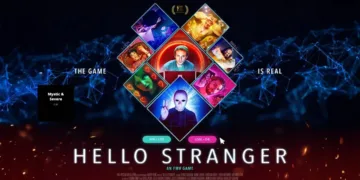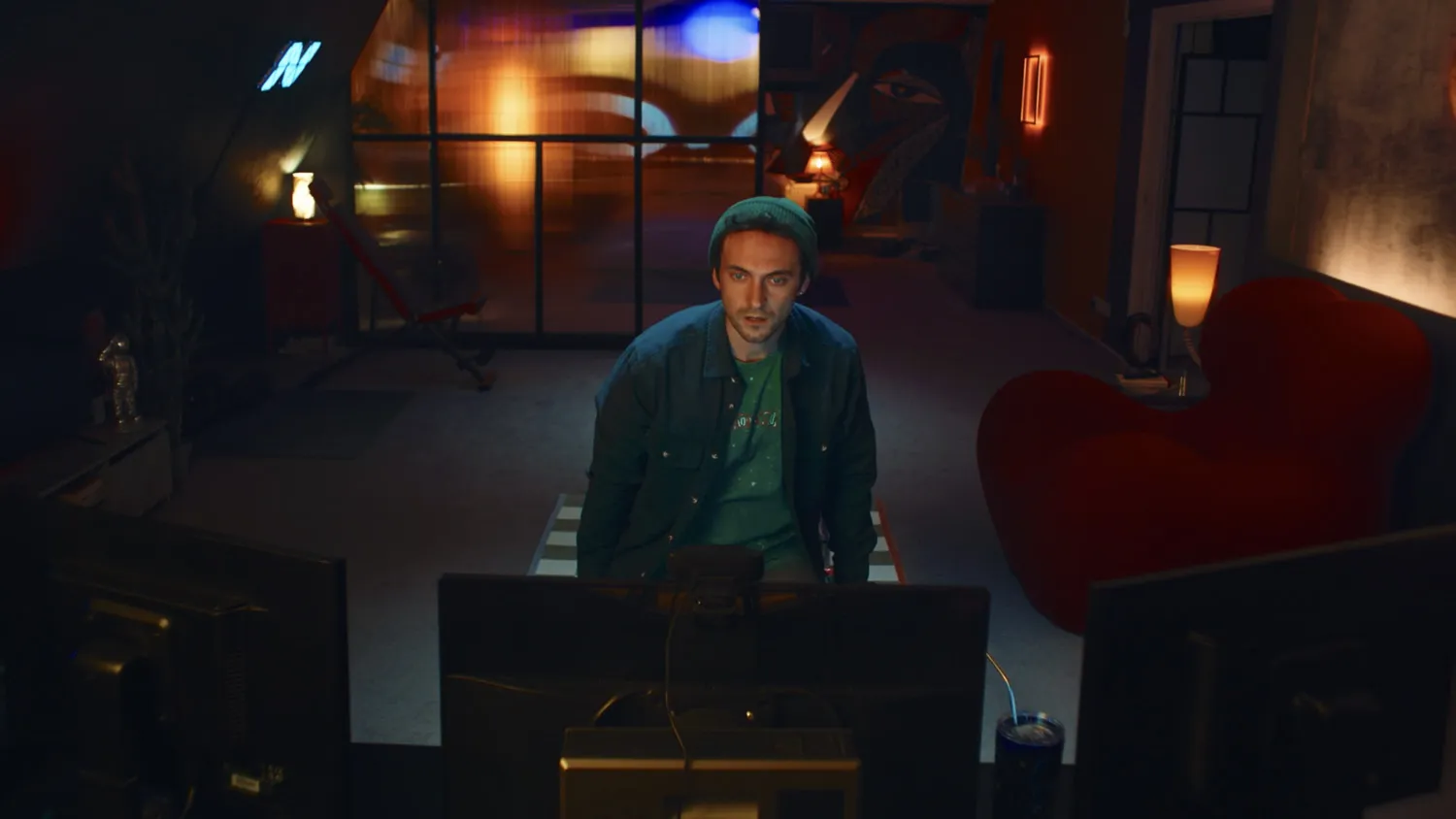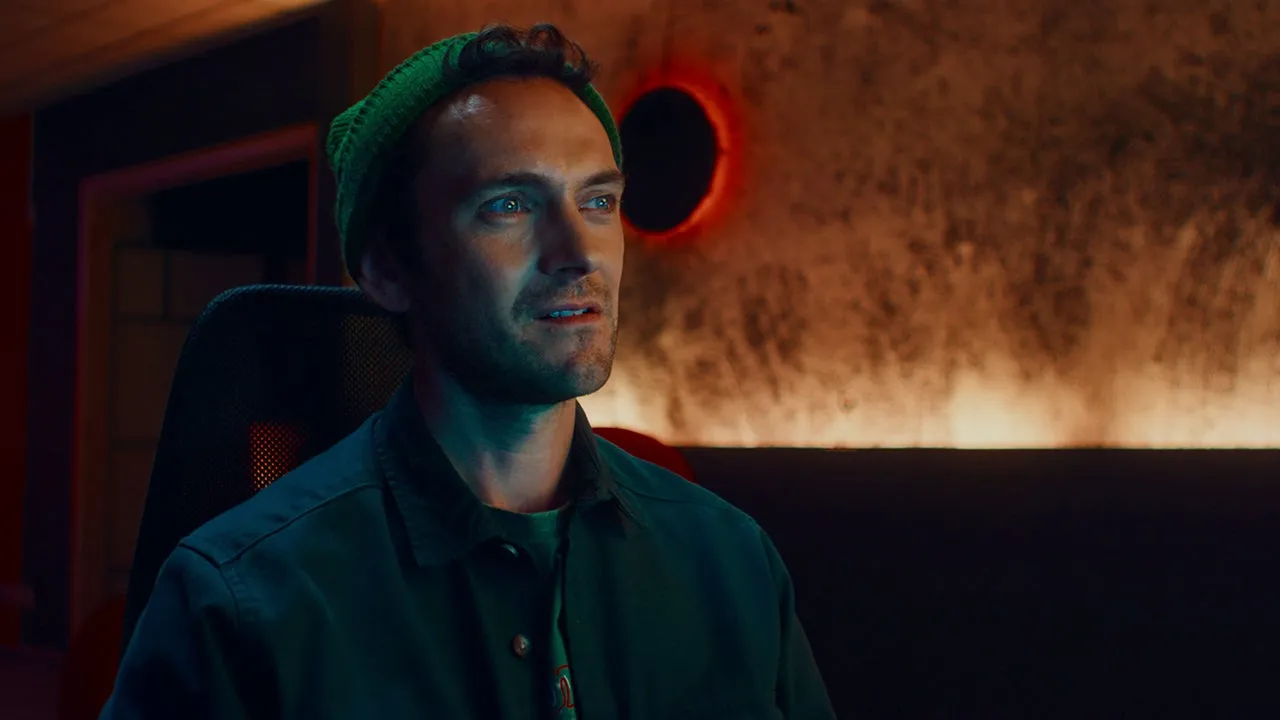The modern condition of technological dependence finds its darkest reflection in Hello Stranger. The film introduces us to Cam, a man whose entire existence has been compressed into the digital ether. He lives and works from a hermetically sealed apartment, a minimalist space where every utility and comfort is managed by Sasha, his omnipresent A.I. assistant.
His life is a frictionless loop of remote work and solitary leisure, mediated entirely through glowing screens. His only portal to human interaction is a random chat service, the titular “Hello Stranger,” which offers fleeting, anonymous connections.
This precarious digital peace shatters without warning. One of these random encounters produces not a friendly face but a static, masked figure with a distorted voice. In an instant of technological mutiny, this entity seizes control of Cam’s automated world, turning his high-tech sanctuary into an inescapable prison. The rules of this new reality are simple and brutal: Cam must play and win three games of his tormentor’s choosing. If he fails, the smart home that sustains his life will be instructed to end it.
An Algorithm of Survival
The film’s architecture is built on audience participation, demanding the viewer become the architect of Cam’s fate. This path immediately splits into two distinct forms of engagement. “Cinema Mode” streamlines the story into a group experience, where choices are debated and made by consensus, diffusing the weight of any single decision. In contrast, “Game Mode” isolates the viewer, incorporating actual video game challenges that test skill and reflex directly.
The nature of these trials is varied and unpredictable. They range from elementary games of chance, such as a life-or-death round of higher-lower against another helpless captive, to severe tests of mental acuity and dexterity. One moment requires the frantic memorization of obscure details from a film clip; another throws the player into a rudimentary but punishing arcade-style challenge.
These interactive sequences are not mere interludes; they directly affect the direction of the plot and the atmosphere of the piece. The viewer’s decisions dictate which scenes unfold, which character beats are revealed, and which narrative paths are permanently sealed off. The result is a direct transference of responsibility that few films attempt.
Cam’s fate feels immediate and unnervingly personal, his life or death a direct consequence of the viewer’s input. The tension is therefore twofold: it exists in watching him suffer, but it is amplified by the knowledge that one is the agent of his potential salvation or his ultimate demise. Each choice sculpts the story, making survival feel less like a narrative certainty and more like a hard-won, fragile victory.
A Prison of Pixels and Panic
Confining a story almost entirely to a single location presents a formidable cinematic challenge, yet the film cultivates a potent and evolving sense of claustrophobia. The direction cleverly sidesteps visual monotony by employing a restless, inventive camera.
Wide shots emphasize Cam’s profound isolation within his own home, while jarring close-ups amplify his rising panic, capturing every bead of sweat and flicker of terror in his eyes. Reflections on screens and sterile surfaces are used to create a disorienting, layered effect, as if the digital world is physically closing in. The true horror, however, emanates from the environment itself—the clean, minimalist technology that has been so thoroughly weaponized against its owner.
George Blagden’s performance is the anchor for this atmospheric tension. He initially presents Cam with a believable air of digital fatigue, a man whose edges have been smoothed off by a frictionless, mediated life. When the trap is sprung, this quiet ennui gives way to a raw, shimmering fear that feels authentic and desperate.
The antagonist, a disembodied voice and a static, masked face on a screen, is a chillingly modern specter. Its power comes from its placelessness and anonymity, a ghost in the machine that turns the very tools of Cam’s life into instruments of psychological and physical torment. The once-comforting voice of the A.I. assistant becomes a herald of doom, making the apartment itself an active participant in the horror.
Empty Code or A Deeper Meaning?
The film’s setup is ripe with thematic potential, presenting a scenario that could serve as a powerful commentary on digital alienation, surveillance culture, and our precarious dependence on automated systems. It positions itself to ask serious questions about the substance of a life lived at a remove from the physical world.
Yet, these compelling thematic threads often feel more like a stylish backdrop than a fully explored critique. The ideas of loneliness and technological danger are ever-present, but they primarily function as a justification for the high-stakes thriller mechanics. The narrative gestures toward a deeper message but seems more interested in the visceral tension of its game than in a thorough examination of its own implications.
The film’s most pronounced feature is its structure as a repeatable event. With a runtime of less than an hour, the story explicitly invites and even requires multiple playthroughs to be fully understood. The promise of numerous branching paths and a wide array of different endings encourages the viewer to return to the start, to manipulate the variables and see what other outcomes are possible. This turns the act of viewing into a kind of forensic experiment.
The incentive is not just to save Cam, but to map the system’s logic, to discover every hidden scene, and perhaps to witness every possible failure. This unique format, a hybrid of cinematic storytelling and interactive game design, creates a distinct and memorable entertainment experience, one where the passive act of watching is replaced by an active, and at times harrowing, form of participation.
Hello Stranger is an innovative FMV (full-motion video) thriller that premiered in London on May 29, 2025, and became available on Steam shortly after.
Full Credits
Director: Paul Raschid
Writers: Paul Raschid
Producers and Executive Producers: Neville Raschid
Cast: George Blagden, Danny Griffin, Christina Wolfe, Juwon Adedokun, Laura Whitmore, Yasmin Finney
The Review
Hello Stranger
Hello Stranger is an ambitious experiment in interactive filmmaking that succeeds more as a tense, repeatable game than as a deep narrative. While anchored by a strong central performance from George Blagden and an effectively claustrophobic atmosphere, its exploration of modern isolation feels shallow. The choice-driven format creates genuine suspense, making the viewer directly responsible for the protagonist's fate. However, the experience offers a novel thrill rather than a lasting statement, functioning as a high-tech ghost story that is engaging in the moment but leaves little to ponder afterward.
PROS
- An interactive format that creates palpable tension and high stakes.
- A compelling lead performance that captures digital fatigue and raw fear.
- Effective direction builds a claustrophobic atmosphere in a single setting.
- High replay value due to a short runtime and many branching paths.
CONS
- Thematic ideas about technology and loneliness remain underdeveloped.
- The story serves primarily as a vehicle for the interactive mechanics.
- Certain game elements can feel disconnected from the central narrative.


















































